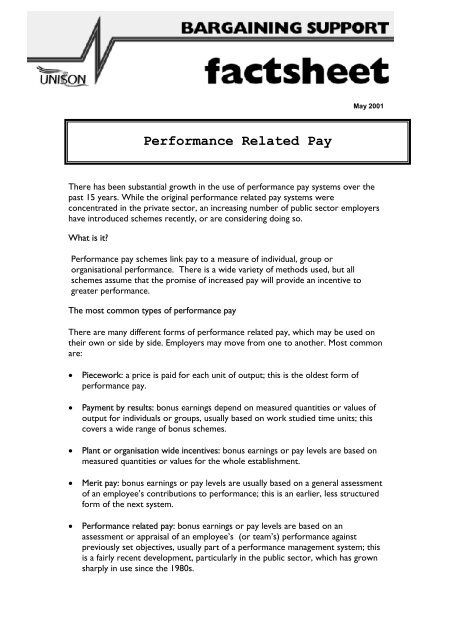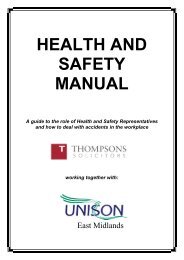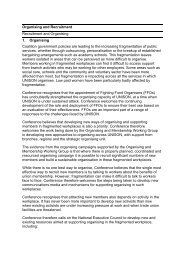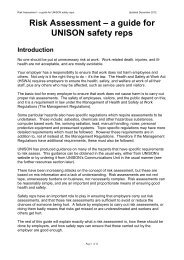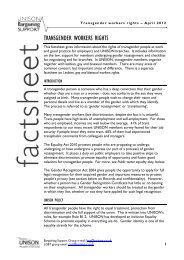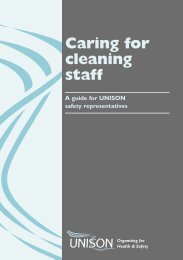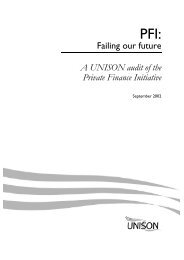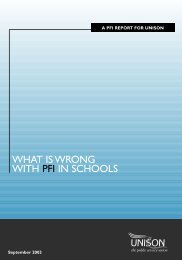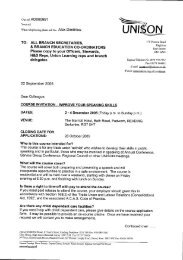Performance Related Pay - Unison
Performance Related Pay - Unison
Performance Related Pay - Unison
You also want an ePaper? Increase the reach of your titles
YUMPU automatically turns print PDFs into web optimized ePapers that Google loves.
May 2001<br />
There has been substantial growth in the use of performance pay systems over the<br />
past 15 years. While the original performance related pay systems were<br />
concentrated in the private sector, an increasing number of public sector employers<br />
have introduced schemes recently, or are considering doing so.<br />
What is it?<br />
<strong>Performance</strong> <strong>Related</strong> <strong>Pay</strong><br />
<strong>Performance</strong> pay schemes link pay to a measure of individual, group or<br />
organisational performance. There is a wide variety of methods used, but all<br />
schemes assume that the promise of increased pay will provide an incentive to<br />
greater performance.<br />
The most common types of performance pay<br />
There are many different forms of performance related pay, which may be used on<br />
their own or side by side. Employers may move from one to another. Most common<br />
are:<br />
� Piecework: a price is paid for each unit of output; this is the oldest form of<br />
performance pay.<br />
� <strong>Pay</strong>ment by results: bonus earnings depend on measured quantities or values of<br />
output for individuals or groups, usually based on work studied time units; this<br />
covers a wide range of bonus schemes.<br />
� Plant or organisation wide incentives: bonus earnings or pay levels are based on<br />
measured quantities or values for the whole establishment.<br />
� Merit pay: bonus earnings or pay levels are usually based on a general assessment<br />
of an employee’s contributions to performance; this is an earlier, less structured<br />
form of the next system.<br />
� <strong>Performance</strong> related pay: bonus earnings or pay levels are based on an<br />
assessment or appraisal of an employee’s (or team’s) performance against<br />
previously set objectives, usually part of a performance management system; this<br />
is a fairly recent development, particularly in the public sector, which has grown<br />
sharply in use since the 1980s.
� Competence based pay: reward and training are linked to competency<br />
frameworks, based on the worker demonstrating certain skills (eg. problem<br />
solving, decision making, leadership, customer service, dealing with differing<br />
views) or achieving certain qualifications.<br />
� Profit related pay: bonus or share options are based on the organisation’s profit<br />
performance; this is widespread in the private sector, where share options are<br />
often important for senior managers. Profit related pay has become less common<br />
since the government phased out tax relief on PRP schemes.<br />
The key to all performance pay systems<br />
The key to all performance pay systems is the measurement required to determine<br />
the output on which to base payments. The main steps are:<br />
� Setting objectives<br />
� Appraisal results<br />
� Linking achievements to pay (and deciding where the money comes from).<br />
Why do employers introduce performance related pay?<br />
� to clarify objectives and engage employees with the organisation’s goals<br />
� to motivate employees by linking pay to achievement of targets not length of<br />
service<br />
� to reward achievement and identify under performance; foster teamwork and<br />
fairness.<br />
� to contribute to overall improvements in productivity;<br />
� to introduce more flexible pay systems or deal with recruitment and retention<br />
problems<br />
� in the case of some employers, to give greater power to managers and weaken<br />
trade union influence in bargaining and representation of staff.<br />
Does it work?<br />
The effectiveness of any pay system depends many factors. However, there are some<br />
problems inherent in all performance related pay schemes:<br />
� Staff motivation and moral – A wide range of research has found schemes less<br />
effective than expected. In the public sector this is frequently due to cash limits<br />
making rewards for high performance ratings too small to motivate staff.<br />
Problems of poor training for managers and inadequate communication with staff<br />
have had a negative impact on staff morale. Studies of NHS managers in 1997 and<br />
1998 showed that performance-related pay did not contribute to improve
performance but did cause jealousies between staff and undermine moral.<br />
(Dowling and Richardson, 1997, Marsden and French, 1998).<br />
� Fairness -- Because performance related pay systems are based on appraisal of<br />
the individual worker, often by their line manager, bias and personal favouritism<br />
can influence the result of pay reviews. Instead of motivating workers,<br />
performance pay can “undermine performance of both the individual and the<br />
organisation by undermining team work, encouraging a short term focus and<br />
leading people to believe that pay is not related to performance, but to having<br />
the ‘right’ relationships and an ingratiating personality”. (Jeffrey Pfeffer, Harvard<br />
Business Review, May/June 1998)<br />
� Discrimination – Recent research found that performance based pay systems<br />
often discriminate against women because: the appraisal process is subject to<br />
gender bias and stereotypes; women’s skills are often undervalued by their<br />
managers (and by women themselves); women—especially those working parttime<br />
-- have fewer opportunities for training, and managers are less likely to<br />
correctly assess women’s training needs. (M.T. Strebler, M. Thompson, P.<br />
Heron, Skills, Competencies and Gender; Issues for pay and training, IES Study<br />
333, 1997). <strong>Performance</strong> pay may run counter to the development of objective,<br />
gender neutral job evaluation schemes which are being introduced to achieve<br />
equal pay for work of equal value. A study by the Institute of Personnel and<br />
Development, found that almost two-thirds of employers had no provision for<br />
monitoring sex and racial discrimination in their performance related pay<br />
systems.<br />
Where PRP is introduced, UNISON supports the following safeguards:<br />
� Negotiability on objective and design – There should be trade union involvement<br />
from the start, with input on who should be included/excluded from the scheme;<br />
the relationship between employment and pay; how the scheme will operate,<br />
including joint monitoring and the appeals procedure.<br />
� Transparency -- The basis for appraisal and how rewards are arrived at should be<br />
transparent at both the individual and collective level.<br />
� Fairness in operation -- There should be a fair and equitable approach to the way<br />
the scheme is carried out for all staff. In competence pay schemes, all staff should<br />
have equal access to training.<br />
� Piloting -- The scheme should be piloted to ensure that it achieves its objectives<br />
and does not operate unfairly.<br />
� Adequate appraisal – Sufficient time should be available to managers to carry out<br />
any appraisals. The workload implications can be considerable, especially for a<br />
complex scheme.<br />
� Training – Training should be available for all managers and staff.
Additional reading<br />
ACAS, Appraisal <strong>Related</strong> <strong>Pay</strong>, 1997<br />
Dowling, G. and Richardson, R, Evaluating performance pay for managers in the<br />
National Health Service; International Journal of Human Resource Management,<br />
Volume 8, No. 3, June 1997<br />
IDS Studies, <strong>Performance</strong> <strong>Related</strong> <strong>Pay</strong>, IDS 650, June 1998<br />
Competency Frameworks, IDS 706, April 2001<br />
UNISON, Competency Based <strong>Pay</strong>, 1996<br />
UNISON Bargaining Support Group, 1 Mabledon Place, London WC1H 9AJ<br />
Tel: 020 7388 2366 Fax: 020 7551 1766 Email: bsg@unison.co.uk


